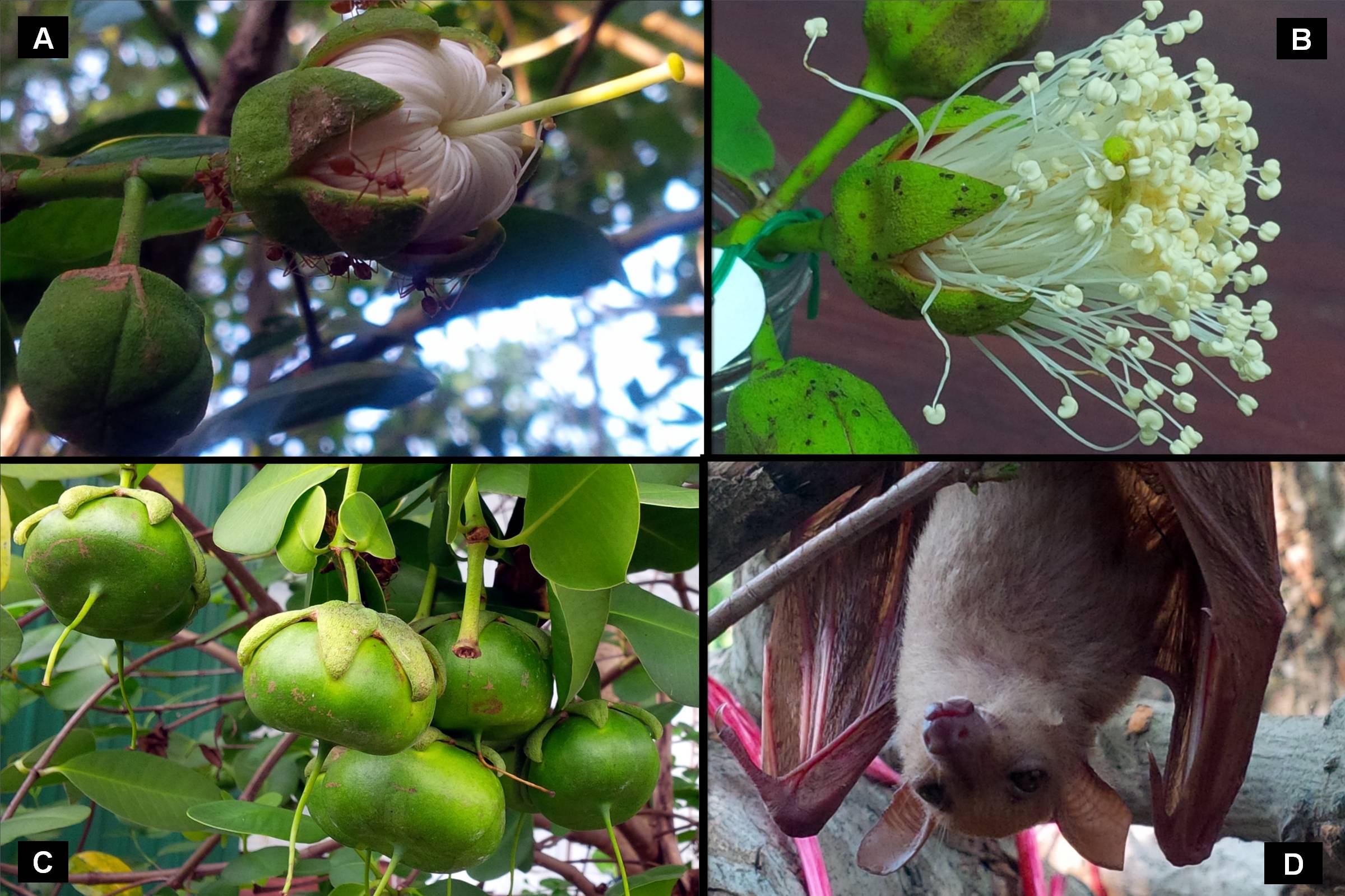Pollinators Increase Reproductive Success of a Self-Compatible Mangrove, Sonneratia ovata, in Southern Thailand
Keywords:
bat pollination, herkogamy, Macroglossus minimus, mangrove apple, pollination experimentAbstract
Sonneratia ovata is a true mangrove species that is dwindling in numbers. To save this species, understanding its ecology and reproduction is necessary. We hypothesized that S. ovata is self-compatible but is more reproductively successful with biotic pollination. To confirm that, a pollination experiment was conducted and reproductive success was measured through pollination success, fruit set, and seed set. Floral visitors were observed. Pollination success in the hand-self treatment was higher compared to all other treatments, confirming its self-compatibility. However, pollination success was not significantly different for non-hand-pollinated treatments. Fruit set was higher in the animal-pollination treatments than in the spontaneous autogamy treatment, possibly due to herkogamy. Seed set results were similar to fruit set results for non-hand-pollinated treatments, indicating higher reproductive success when animal-pollinated. Only Macroglossus minimus was caught near S. ovata flowers, suggesting that S. ovata may be dependent on a single species of bat for pollination. Therefore, it is important to protect, not only this mangrove species, but also their bat pollinators and the forests where these bats roost.
References
Bates, D., Maechler, M., Bolker, B., Walker, S. 2015. Fitting linear mixed-effects models using lme4. Journal of Statistical Software 67, 1–48. https://doi.org/doi:10.18637/jss.v067.i01.
Bumrungsri, S., Sripaoraya, E., Chongsiri, T., Sridith, K., Racey, P.A. 2009. The pollination ecology of durian (Durio zibethinus, Bombacaceae) in southern Thailand. Journal of Tropical Ecology 25, 85–92. https://doi.org/10.1017/S02664674080 05531.
Climatological Center, Meteorological Development Bureau. 2017. Annual weather summary over Thailand in 2016. Thai Meteorological Department.
Coupland, G.T., Paling, E.I., McGuinness, K.A. 2006. Floral abortion and pollination in four species of tropical mangroves from northern Australia. Aquatic Botany 84, 151–157. https://doi.org/10.1016/j.aquabot.2005.09.003.
Coupland, G.T., Paling, E.I., McGuinness, K.A. 2005. Vegetative and reproductive phenologies of four mangrove species from northern Australia. Australian Journal of Botany 53, 109–117.
Department of Marine and Coastal Resources, 2012. Mangrove plant species in Thailand, Bangkok, 179 pp.
Duke, N.C., Jackes, B.R. 1987. A systematic revision of the Mangrove genus Sonneratia (Sonneratiaceae) in Australasia. Blumea 32, 277–302.
Francis, C.M., 2008. A field guide to the mammals of South-East Asia, First. ed. New Holland Publishers (UK) Ltd., London, 392 pp.
Lenth, R., Singmann, H., Love, J., Buerkner, P., Herve, M. 2019. emmeans: Estimated Marginal Means, aka Least-Squares Means.
Nor Zalipah, M. 2014. The role of nectar-feeding bats (Pteropodidae) in the pollination ecology of the genus Sonneratia at Setiu mangrove areas, Terengganu, Malaysia. PhD Dissertation. University of Bristol, 210 pp.
Nor Zalipah, M., Ahmad Fadhli, A. 2017. Experimental pollinator exclusion of Sonneratia alba suggests bats are more important pollinator agents than moths. Journal of Sustainability Science and Management Special Issue Number 3: Improving the Health of Setiu Wetlands Ecosystems and Productivity of Crustacean Resources for Livelihood Enhancement 2017, 16–23.
Nuevo Diego, C.E. 2018. Floral Characteristics and Pollination of Sonneratia spp. (Lythraceae) in Southern Thailand. MSc thesis. Prince of Songkla University, Hat Yai, Thailand, 107 pp.
Ollerton, J., Winfree, R., Tarrant, S. 2011. How many flowering plants are pollinated by animals? Oikos 120, 321–326. https://doi.org/10.1111/j.1600-0706.2010.18644.x.
Pandit, S., Choudhury, B.C. 2001. Factors affecting pollinator visitation and reproductive success in Sonneratia caseolaris and Aegiceras corniculatum in a mangrove forest in India. Journal of Tropical Ecology 17, 431–447. https://doi.org/10.1017/S02 66467401001298.
Polidoro, B.A., Carpenter, K.E., Collins, L., Duke, N.C., Ellison, A.M., Ellison, J.C., Farnsworth, E.J., Fernando, E.S., Kathiresan, K., Koedam, N.E., Livingstone, S.R., Miyagi, T., Moore, G.E., Nam, V.N., Ong, J.E., Primavera, J.H., Salmo, S.G.I., Sanciangco, J.C., Sukardjo, S., Wang, Y., Yong, J.W.H. 2010. The loss of species: Mangrove extinction risk and geographic areas of global concern. PLoS One 5, e10095. https://doi.org/10.1371/journal.pone.0010095.
Pornpinatepong, S., Tanaka, H., Takasaki, M. 2011. Application of 2-D vertically averaged boundary-fitted coordinate model of tidal circulation in Thale Sap Songkhla, Thailand. Walailak Journal of Science and Technology (WJST) 3, 105–118. https://doi.org/10.2004/wjst.v3i1.153.
Primack, R.B., Duke, N.C., Tomlinson, P.B. 1981. Floral morphology in relation to pollination ecology in five Queensland coastal plants. Austrobaileya 1, 346–355.
Salmo, S.G.I., Fernando, E.S., Peras, J.R., Sukardjo, S., Miyagi, T., Ellison, J.C., Koedam, N.E., Wang, Y., Primavera, J.H., Jin Eong, O., Wan Hong Yong, J., Ngoc Nam, V. 2010. Sonneratia ovata. The IUCN Red List of Threatened Species 2010: E.T178814A7615033.
Sánchez-Núñez, D.A., Mancera-Pineda, J.E. 2012. Pollination and fruit set in the main neotropical mangrove species from the Southwestern Caribbean. Aquatic Botany 103, 60–65. https://doi.org/10.1016/j.aquabot.2012.06.004.
Stewart, A.B., Dudash, M.R. 2016. Flower‐visiting bat species contribute unequally toward agricultural pollination ecosystem services in southern Thailand. Biotropica 49, 239–248. https://doi.org/10.1111/btp.12401.
Sutherland, S. 1986. Patterns of fruit set: What controls fruit-flower ratios in plants? Evolution 40, 117–128.
Tomlinson, P.B. 1986. The Botany of Mangroves, Cambridge Tropical Biology Series. Cambridge University Press, New York, USA, 413 pp.
Turner, I.M. 2004. The ecology of trees in the tropical rain forest, Cambridge Tropical Biology Series. Cambridge University Press, Cambridge, United Kingdom, 298 pp.
Watzke, S. 2006. Resource utilization and mating system of the nectarivorous species Macroglossus minimus (Pteropodidae: Macroglossinae) in western Malaysia [Ressourcennutzung und paarungssystem der nektarivoren flughundart Macroglossus minimus (Pteropodidae: Macro-glossinae) in West-Malaysia]. PhD Thesis. Ludwig-Maximilians-Universität München, 186 pp.
Wickham, H. 2016. ggplot2: Elegant Graphics for Data Analysis. Springer-Verlag New York, 212 pp.
Wilcock, C., Neiland, R. 2002. Pollination failure in plants: why it happens and when it matters. Trends in Plant Science 7, 270–277. https://doi.org/ 10.1016/S1360-1385(02)02258-6.
Zhou, R., Qiu, S., Zhang, M., Guo, M., Chen, S., Shi, S. 2010. Sonneratia ovata Backer–A genetically depauperate mangrove species. Biochemical Systematics and Ecology 38, 697–701. https:// doi.org/10.1016/j.bse.2010.04.012.

Downloads
Published
How to Cite
Issue
Section
License
Chulalongkorn University. All rights reserved. No part of this publication may be reproduced, translated, stored in a retrieval system, or transmitted in any form or by any means, electronic, mechanical, photocopying, recording or otherwise, without prior written permission of the publisher







